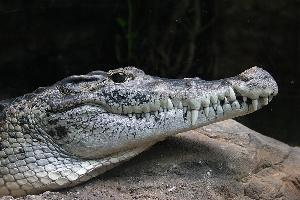
Váhy a míry
| Délka | od 2,7 do 3,5 m |
|---|
Popis zvířete
The New Guinea crocodile (Crocodylus novaeguineae) is a fascinating and unique species of crocodile found primarily in the freshwater habitats of New Guinea, an island that is politically divided between Papua New Guinea in the east and Indonesia in the west. This species has adapted remarkably to its environment, showcasing a blend of physical characteristics and behaviors that make it a standout among the crocodilian family.Physically, the New Guinea crocodile is a robust creature, with adult males reaching lengths of up to 3.5 meters (11.5 feet), though some individuals have been reported to grow even larger. Females are generally smaller than males, a common sexual dimorphism among crocodiles. The skin of these crocodiles is a dark green or black, with a rugged texture that provides camouflage in their murky aquatic habitats. Their underbelly, however, is much lighter, often a creamy white or pale yellow. This coloration is not just for camouflage; it also plays a role in thermoregulation, helping the crocodile absorb or deflect heat from the sun.
One of the most distinctive features of the New Guinea crocodile is its narrow snout, which is well adapted for catching a variety of prey. Their diet is diverse, consisting of fish, birds, small mammals, and occasionally, smaller reptiles. Their sharp, conical teeth are designed to grip slippery prey, ensuring that once caught, escape is nearly impossible.
New Guinea crocodiles are primarily nocturnal hunters, relying on the cover of darkness to approach their prey undetected. During the day, they can often be found basking on riverbanks or partially submerged in water, conserving energy for their nighttime activities. They are excellent swimmers, with powerful tails that propel them through the water with surprising speed and agility.
Reproduction in New Guinea crocodiles involves complex mating rituals that typically occur during the dry season. Females lay eggs in nests made of vegetation, which provides insulation and helps regulate the temperature of the developing embryos. The number of eggs laid can vary, but clutches typically contain between 20 to 80 eggs. The female guards the nest vigilantly until the eggs hatch, which can take about 80 to 90 days. The sex of the offspring is determined by the temperature of the nest, a phenomenon known as temperature-dependent sex determination, common among crocodilians.
Conservation efforts for the New Guinea crocodile are ongoing, as their populations face threats from habitat destruction, pollution, and hunting. In some areas, they are hunted for their meat and skin, which is highly valued in the fashion industry. However, compared to other crocodile species, the New Guinea crocodile is considered to be at a lower risk of extinction, thanks in part to its remote habitat and some local conservation initiatives.
In summary, the New Guinea crocodile is a remarkable reptile, perfectly adapted to its environment on the island of New
Mapa výskytu

Podobná zvířata
Nové fotografie zvířat
Top 10 zvířat
- Dolphin gull (Leucophaeus scoresbii)
- Diana monkey (Cercopithecus diana)
- Moustached guenon (Cercopithecus cephus)
- Galápagos tortoise (Geochelone nigra complex)
- Stone loach (Barbatula barbatula)
- Japanese macaque (Macaca fuscata)
- Russian tortoise (Testudo horsfieldii)
- Greek tortoise (Testudo graeca)
- Common flying dragon (Draco volans)
- Vendace (Coregonus albula)


